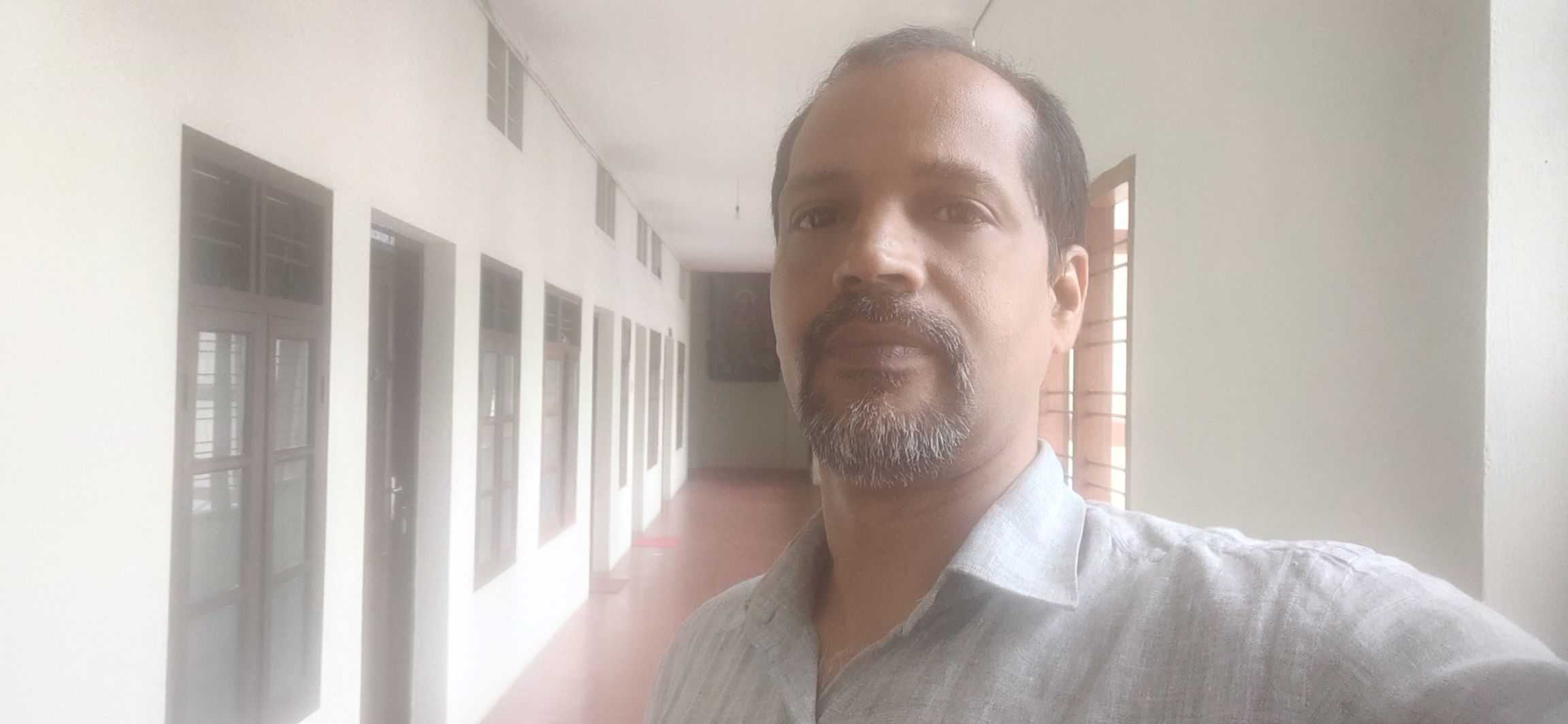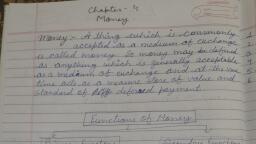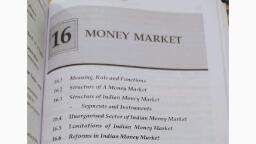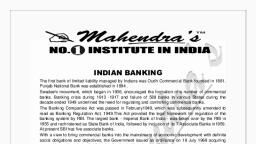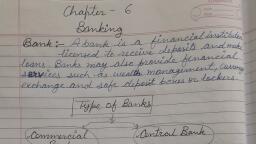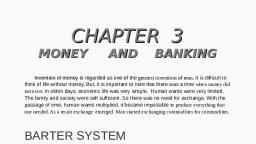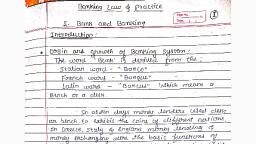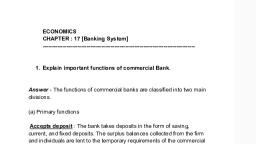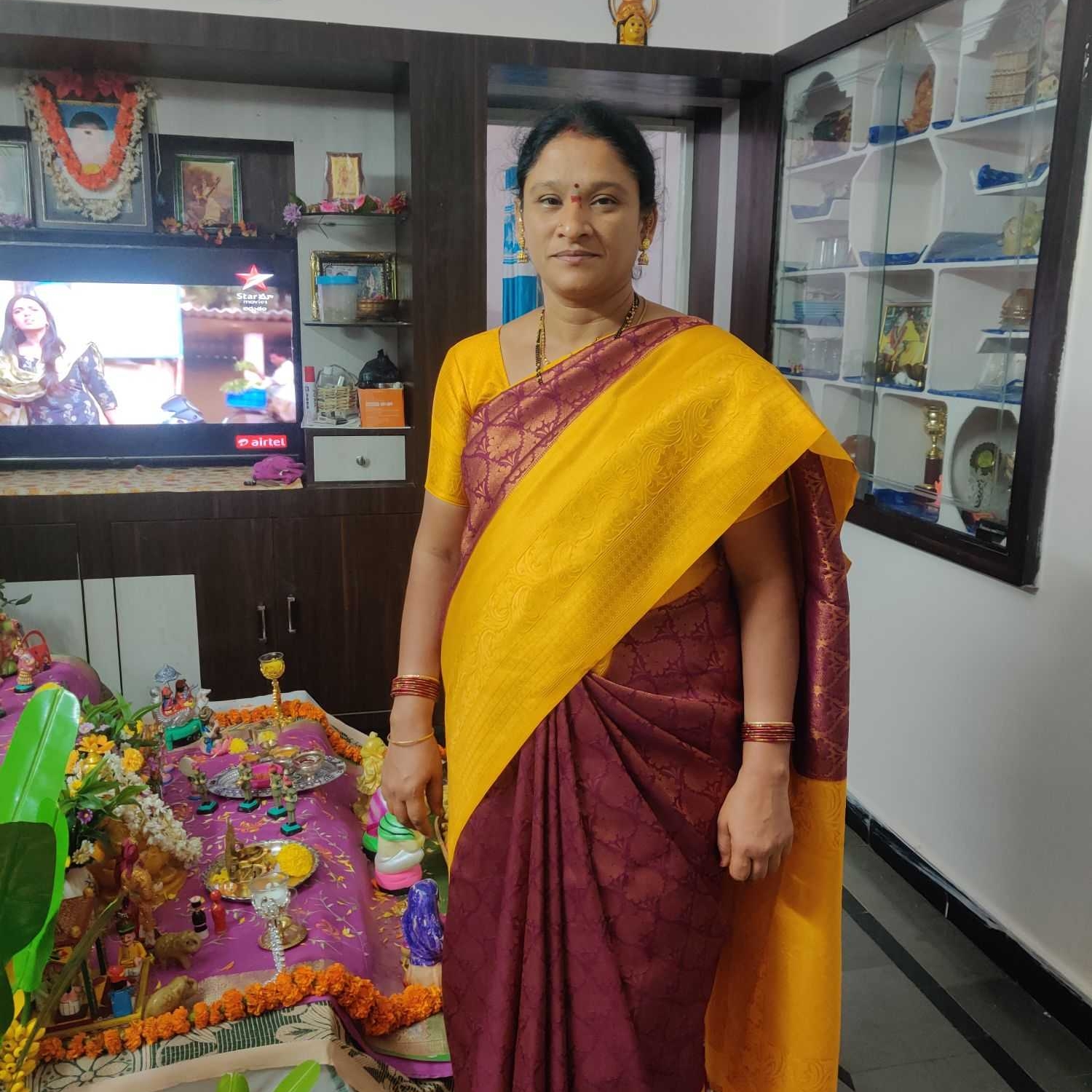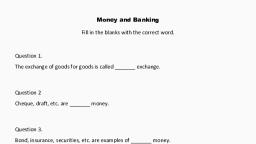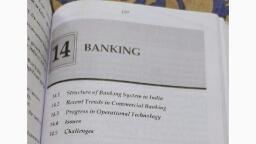Page 1 :
Introduction, , Invention of money is regarded, as one of the greatest inventions of, man. Modern economy is called money, economy. It is difficult to think of life, without-money, But, it is important, to note that there was a time when, money did not exist. In the olden, days, economic life was very simple., Human wants were very limited. The, family and society were self sufficient., Therefore, there was no need for, exchange. With the passage of time,, human wants multiplied. It became, impossible to produce everything that, one needed. This led to specialisation., As a result, exchange emerged. Man, started exchanging commodities for, commodities. This system of exchange, is known as the barter system., , Barter System, , The system in which one commodity, is exchanged for another is called barter, system. For example, people bought a, cow in exchange for a sack of paddy,, or exchange paddy for vegetables and, food grains. This system of economy, , - Wherein goods were exchanged for other, 800ds is known as C - C Economy,, i.e., commodities are exchanged for, , commodities., , , , Drawbacks of the Barter System, , 1. Absence of double coincidence, , of wants, , Barter system works smoothly only, if the wants of the buyer and the seller, coincide. For example, if a person, wants to sell cloth to buy rice, he has, to find a person who wants to sell rice, and buy cloth. But if one wants to sell, rice and buy vegetables, the transaction., will not take place. This difficulty of, double coincidence of wants is a major, drawback of the barter system., , 2. Absence of common measure of, value, , Under the barter system there is, no common measure of value. Different, goods are exchanged on different”, measures of value., , 3. Lack of store of value, , _ Under the barter system, a person’s, wealth is stored only in the form of, commodities. Most of the commodities, are not durable. So they cannot be, stored fora long time. Moreover, they, require a lot of storing space. This is, another drawback of barter system., , 4. Lack of standard of deferred, payments :, , ‘This means there is no standard, basis for borrowing and lending. For, example, if a cow is borrowed, its value, changes at the time it is returned to, , Scanned with CamScanner
Page 2 :
'¢ 158, , the lender. The value may increase or, decrease., , 5. Problems of divisibility, , Some goods cannot be divided. For, example, if the exchange for a cow with, a bag of paddy, and if only half a bag, of paddy is needed, the cow cannot be, divided. ., , These problems of barter system, led to the emergence of money., What is Money?, , Economists have given different, definitions for money. According to, the legal definition, money is anything, generally accepted. Walker defines, money as “Money is what money does’., Therefore, money is defined as anything, which is generally accepted as a, medium of exchange, measure of unit of, account, store of value and a standard, for deferred payments., , _ Functions of Money, , Money performs many useful, functions. These functions can be, broadly classified into three. They are:, , I. Primary Functions, 1. A medium of exchange, 2. Ameasure of value, II. Secondary Functions, 3. A store of value, , 4, A standard of deferred payments, , 5. A transfer of value, III. Contingent Functions 6. Basis of credit, , 7, Liquidity, , Economics — Il, , , , , , g, Distribution of national income, 9, Guarantor of solvency, , I. Primary Functions, , Medium of exchange: During the, barter system, commodities were, exchanged for commodities. In, modern times, goods and services, are bought and sold with money,, Thus, money serves as a medium., of exchange., , A measure of value: Money is, used to measure the value of goods, and services. When the value of, goods and services is expressed, in the form of money it is called, price. When we say that the price, of orange is ¥ 50 per kg., we are, expressing the value of orange, in terms of money. Thus money, becomes a unit of account., , II. Secondary Functions, , 3..A store of value: Wealth can be, stored in the form of money. Thus, money serves as an asset or a, store of value. Currency held by, the people or demand deposits in, banks are examples of stores of, value. :, , 4. Astandard of deferred payments:, Deferred payment is payment after, a lapse of time. In other words,, .deferred payments are future, payments. Money is the unit of, account in contracts that involvé, future payments., , A transfer of value: Sale and, purchase of goods, property, ett, result in the transfer of value fro™, one person to another. Simila* y, money facilitates transfer of value, from one place to. another. ThU®, money helps in transferring V:, , 5., , alues:, , , , ad, , Scanned with CamScanner
Page 3 :
iL Contingent Functions, , 6. Basis of credit: Modern economy, and business are based on credit., Money is the basis of credit., , 7, Liquidity: Liquidity means ready, purchasing power, All assets are, not liquid, that is, they are not, acceptable in all forms of exchange., Money is the most liquid of all, assets., , 8. Distribution of national income:, The contribution of various factors, to national income is expressed, , in money. Factor rewards are, expressed in money. Thus, money, facilitates distribution of national, , . income., , _ 9, Guarantor of solvency: Solvency, refers to the ability of a person to, pay his debt. If a person fails to, honour his obligations, he becomes, insolvent. Money guarantees, solvency. ' ., This is the age of digitisation. Digital, , transactions are increasing. The world, , - is moving towards a cashless system., , Transactions are settled through, , digital information. Here, instead of, , transactions through physical currency, , Notes and coins, digital information is, , used for transactions. This is electronic, , Tepresentation of money., , In India, government has been, Promoting digitisation of transactions., The JAM trinity - Jan Dhan accounts,, Aadhar, Mobile - has been very useful, in achieving financial inclusion. Also,, €-wallets, National Financial Switch, (NFS) and others have strengthened the, 80vernment’s effort to go cashless. The, Spread of mobiles and smart phones, , ave been very helpful in achieving, , Money and Banking, , , , , , 159 2), ilttammen i, financial inclusion. In India, as on May, 2020, there are 36 crore Jan Dhan, accounts. During the Covid-19 crisis,, , the government transferred money into, these accounts to help the poor., , Central Bank, , Every country has a central bank., The Central Bank is the apex institution, ofa country’s monetary system. India’s, Central bank is the Reserve Bank of, India. RBI came into existence in 1935., , Functions, , The important functions of the, Central bank are briefly described, below:, , (1) Issue of Currency, , The Central bank is the monetary, authority. It has monopoly power of, printing and issuing currency notes., RBI in India prints all denominations of, currency notes except one rupee notes., One rupee notes and coins are issued, by the Finance Ministry, Government, of India., , (2) Bankers’ Bank, , The Central bank functions as the, bank of banks. It controls commercial, banks and other financial institutions., In times of need, the Central. bank, provides assistance to commercial, banks. That’s why the Central bank is, called bankers’ bank, , (3) Banker to the Government ., , The Central bank is the banker, to the government. It performs all the, banking business of the government., The Central bank accepts money and, makes payments on behalf of the, government as its agent. It also advises, the government on monetary matters., , , , , , Scanned with CamScanner
Page 4 :
i¢ 160, , (4) Controller of Money Supply, , Another important function of the, Central bank is to act as the controller, of money supply. The Central bank, controls the total size of money supply, and credit. It maintains economic, stability by changing bank rate, cash, reserve ratio, etc., , (5) Custodian of Foreign Exchange, , The Central bank is the custodian, of the foreign exchange reserves of the, nation. Gold reserves of the nation are, also kept by the Central bank., , (6) Lender of Last Resort, , When commercial banks face, financial crisis, RBI plays a crucial, role. Commercial banks approach the, RBI for assistance as a last resort., When RBI extends, helping hand to, commercial banks in times of financial, difficulties, RBI may be called lender of, last resort., , (7) National Clearing House —, , The Central bank acts as a clearing, house for transfer and settlement of, mutual claims of commercial banks., Bank to bank clearing and settlement, through the central bank is easy since, the Central bank holds cash reserves, of commercial banks., , (8) Publication of Report, , Another important function of, the Central bank is publication of, reports on banking, currency, finance, , - and macroeconomy. In India the, RBI publishes reports on important, economic and financial indicators., , Commercial Banks, Commercial banks are hugely, t in the financial and banking, , importan', i f the economy. They mainly, , - system 0, , Economics ~ I], , , , , , , , , Sa, accept deposits and give loans. The, difference between the deposit rate, and the lending rate, known as the, spread, is the main source of profit of, the banks., Functions, , The functions of commercial banks, can be described as given below:, , 1, Primary Functions, , (1) Accepting Deposits, , The traditional and important, function of commercial banks is, accepting deposits. Commercial banks, usually accept three types deposits, from the public:, , (a) Savings Deposit, (b) Current Deposit and, (c) Fixed Deposit., , (2) Giving Credit, , Commercial banks give loans to, those who need them on security., Credit is given as cash credit, call loan,, overdraft, etc. Loans given as cash on, the security of material assets is cash, credit. Loans which are to be repaid on, call, are called call loans. Overdraft is, another facility given to the customers:, It allows the account holders to draw, , from the bank amount higher than the, , cash balance in their accounts., (3) Discounting Bills of Exchange, , A customer with a bill of exchange, can, in times of need, approach @, commercial bank for money. The b', , will give money after discounting th®, bill of exchange, : = ;, , (4) Credit Creation, , _ Commercial banks can create, credit. A person approaches a bank 0", a loan. The bank sanctions the loan”, proper security, But the loan amou™, , Scanned with CamScanner
Page 5 :
ae, , jg not given directly to the borr, Instead, it is deposited in the flame, the same borrower. Thus every loan, creates a deposit. :, , (5) Investment, , After giving loans the banks will still, have money left with them. This excess, money is invested. Banks are bound by, Jaw to invest a part of their deposits in, Government approved securities. So, investing is an important function of, commercial banks. Banks usually invest, their funds in Government securities, and other approved securities., , Il, ‘Secondary Functions, , i The secondary functions can be, classified under two heads:, , (a) Agency Functions, , Bank works as an agent of the, customers and charges commission., , () Transfer of funds: Transfer money, , - from one place to another through, , Drafts, Mail Transfer, Electronic, Transfer, etc. ° :, , (il) Collection of money: Collect, money through cheque, draft, etc., , > (iti) Collect. dividends on shares, and, interest on debentures and bonds., (iy) Pay bill amount, insurance pre", mium, etc. In addition to this, banks, also take up purchase and sale of, shares and financial securities., (v) Execute wills of customers., , (b) Miscellaneous Functions, e and sale of foreign, , 1. ‘Purchas, currency, , 2. Issue of Tr, cheque, etc., , avellers’ cheque, gift, , , , We ara, , Money and Banking, , , , pogroms, , , , G, , 3. Offer safe deposit facilities to keep, precious things, , 4. Issue of letters of credit, , 5. Issue of ATM card, Credit card and Debit card, , 6... Underwriting of financial securities, like shares during public issue, (underwriting is taking tip purchase, of a part of unsold securities in, public issue) =, , 7. Tele banking, , 8. Internet banking, , ‘III, Development Functions, , 1. Loans to the weaker sections at low, rates of interest, , 2. Loans.to the unemployed to find, , employment, 3... Loans for priority sector, Money Creation by the Banking System, , As explained banks can create credit, because of the unique characteristic of, the banking transactions. All depositors, do not come to the bank and demand, their deposits at the same time. For a, better understanding of the process of, credit creation let us learn the basics of, accounting and balance sheet briefly., , Balance sheet is the record of, assets and liabilities of any business., Assets are recorded on the left side of, the balance sheet and liabilities are _, recorded.on the right side. This is the~, globally accepted convention. Accordirig, to the rules of accounting, both sides, of the balance sheet should balance., That is assets and liabilities should, balance. Both sides should be equal., Thus, assets always equal liabilities., , Assets are what a firm owns and, what others owe to the firm. Let us, , Scanned with CamScanner
